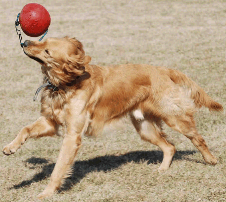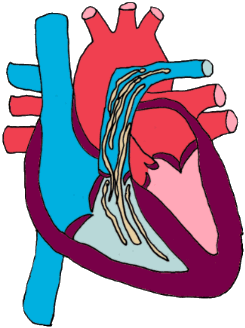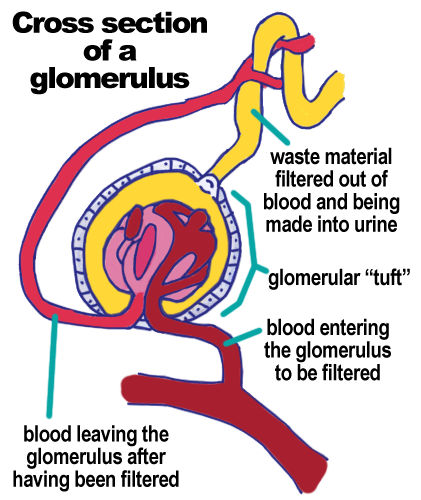|
SO WHAT HAPPENS TO THE INFECTED DOG?

|
Early infection
We have covered the worm, now let’s cover the dog once he or she becomes infected. As we have said, the migration of the young worm once it enters the dog’s body is a long one: a journey of 5-7 months. In that time, the worm is growing, maturing, and preparing to mate. While all this is happening, nothing is happening to the dog and no one knows an invasion has taken place.
|
 (Photocredit: Morguefile.com) (Photocredit: Morguefile.com) |
HEARTWORM DISEASE: DISEASE IN THE HEART AND BLOOD VESSELS
|
Worms in the Pulmonary Arteries
At the end of this long migration, the worm has reached its destination: a pulmonary artery. The worm is large and takes up a lot of space in the artery. The dog’s immune system recognizes foreign proteins present and launches an attack but the immune system is designed to work against smaller invaders such as bacteria or viruses. The heartworm is too big to be killed effectively this way and the result is inflammation and thickening in the arteries. Blood flow becomes turbulent and the tendency to form abnormal clots is increased. Adding to this unpleasant mix is a bacterium called Wolbachia pipientis, which normally lives inside the heartworm but is released in large numbers every time the heartworm molts to a new developmental stage, gives birth to its young, or dies. These bacteria contribute heavily to the resultant inflammation occurring in the pulmonary arteries and lung tissue itself. Blood vessels get stiff and cannot operate normally, creating a high resistance area that the heart must pump through.
|
 A bunch of heartworms hanging out in the pulmonary artery A bunch of heartworms hanging out in the pulmonary artery
(original graphic by marvistavet.com)
|
The inflammation calls in numerous immune cells which in turn generate even more inflammation as they attempt to destroy a parasite that is realistically too large for them to destroy. The lung itself becomes inflamed and in time becomes scarred creating an even larger high resistance area for the heart to pump through.
If there are many worms, the problem is multiplied. Some pulmonary arteries may actually become fully blocked shut by the crowd of worms. This means that blood cannot pass through these arteries (they are plugged up by a wad of worms). This in turn means the area of lung that would have been served by these arteries is rendered useless. If the lung cannot present its oxygen to a working pulmonary artery, oxygen exchange cannot take place.
DYING WORMS
As if that was not bad enough, the real damage comes from worms that have died in place. The dead body of the heartworm breaks apart and is carried through the vasculature of the lung until it lodges somewhere and obstructs blood flow. The arteries that are supposed to form delicate branches, branching tinier and tinier are now blunted and closed off, similar to a tree branch broken off close to the tree trunk. As above, this leaves more areas of lung blocked off and unable to receive blood and participate in oxygen exchange.
SCARRING
All the inflammation generated by the presence of worms as well as the inflammation generated by the areas of lung not receiving proper circulation ultimately translates into scarring in the lung vasculature. Scarring and fibrosis makes it difficult for the heart to pump blood through the lung effectively. There is a point where the heart is not strong enough to pump blood through all the narrowed, stiff, damaged capillary beds. Right sided heart failure ensues.
HOW MANY WORMS ARE TOO MANY?
In naturally infected dogs, the number or worms does not correlate to severity of disease, even in dogs of the same size. It's not the number of worms that matters so much as the activity level of the dog. The factors that come into play to create severity of disease are: the dog’s activity level (the more active the dog, the fewer worms are needed to create disease), the size of the dog, and the number of worms present. The infected dog that sits around at home may appear relatively normal but once some exercise or even anxiety puts more demand on his heart, symptoms erupt.
|
SYMPTOMS OF HEARTWORM DISEASE
- Coughing
- Shortness of Breath/Panting
- Easy tiring/intolerance of exercise
- Fluid accumulation in the abdomen or chest
- Nose Bleeds
- Sudden Death
Obviously, not all of these things necessarily occur in the same dog, nor is there necessarily a progression. An infected dog may have no symptoms at all or may develop any of the signs on the list at any time.
|

(original graphic by marvistavet.com) |
HEARTWORM DISEASE: DISEASE IN THE KIDNEYS
|
CHRONIC IMMUNE STIMULATION AND KIDNEY DISEASE
A dog harboring heartworms in its body basically has an infection that cannot be cleared. The dog's immune system tries and tries but the worm is too big. This means the immune system is stimulated all the time, long term, and there is damage associated with the by-products of all this stimulation. Antibodies are more than just tools of the immune system; they are inflammatory proteins and in heartworm disease they are produced in high amounts all the time. Antibodies can cause a lot of trouble when they deposit in the delicate membranes of the eye, blood vessels, joints, and kidney. Antibodies stuck in these areas, call in inflammatory cells and damage these delicate membranes thus setting up tremendous tissue damage and pain. In particular, heartworm infection is a cause of a special type of kidney inflammation called “glomerular disease.”
SO WHAT HAPPENS IN GLOMERULAR DISEASE?
The filtration system of the glomerulus keeps proteins inside the body where they belong but allows for tiny waste molecules to be filtered out and dumped in urine. When antibody : antigen complexes abound, they get stuck in the delicate filtration membranes and ultimately punch holes there. As you might guess, a leaky filtration membrane allows for important proteins to be lost. What happens after that depends on what proteins are lost (see the above link for more details) but rest assured, the results are not good. Fortunately, this inflammation and its consequences can frequently be resolved with treatment for heartworm infection.
|

This is a depiction of a kidney structure called a glomerulus.
It has a delicate filtration system for proper urine production.
Antibody : Antigen complexes will disrupt this system,
causing protein loss in urine.
(original graphic by marvistavet.com)
|
CAVAL SYNDROME: A SPECIAL CATASTROPHE
Caval syndrome represents an especially disastrous form of heartworm disease. Here, there are so many worms present (around 100) that the entire right side of the heart is filled with worms and they are backing out into the large veins that feed the right side of the heart. Usually there have been no signs of heart disease prior to the collapse, shock, and red blood cell destruction associated with this syndrome. Death usually occurs within 1 to 2 days and the only effective treatment is to open the dog's jugular vein and physically remove the worms with a special clamp. If enough worms can be removed to re-establish blood flow, the dog may survive.
Heartworm disease is a highly significant problem and must be managed
both by dealing with the worms and by dealing with the heart disease.
|
HEARTWORM IN THE CAT
Heartworm disease is the cat is quite a bit different from heartworm disease in the dog. Cats are so small that only one adult worm could be enough to cause heart failure plus there is much more inflammation involved with the immature worms in the cat. For details on heartworm infection, disease, treatment, and prevention in the cat, click here.
|

(Photocredit: morgue file.com) |

Page last updated: 8/2/2025
|